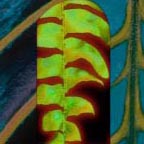
of Norwegian University Museums
The Museum Project
Final report for the Museum Project
However, due to the magnitude and the organisation of the university
collections, they
have not been readily accessible for use in research, teaching and public
services or for inspection by the general public. In order to maintain their
position as the country's leading institutions and information pools for
object-based research, the university museums must revitalise their
collections. An important step in this process is the introduction of
information technology at all levels in the museums. However, this calls for an
extremely costly reassessment and conversion of existing archives into a
digital format, requiring extra effort and additional funding. In some cases,
establishing the databases will entail a complete revision of some of the
museum collections.
The Museum Project was establishedin the spring of 1998 as a
national collaborative project involving all four Norwegian universities. The
idea behind this project is to make use of the experience and expertise gained
through the previous database projects, the Documentation Project (http://www.dokpro.uio.no) and a pilot
project for the museums of natural history called UNADOC.

The Museum Project will comply with the recommendations made by two commissions appointed by Norwegian authorities and with the United Nations' demands concerning global databases on the environment.
The aim of this Project is to develop common database-systems for the management of collections for all the Norwegian university museums. Ideally, these database systems should be able to handle all reference information related to artefact and specimen collections inside and outside the museums. Important aspects include internal requirements regarding the management of collections, fieldwork, research and dissemination, and external demands from the authorities and the public concerning access to reference data.
The Museum Project involves the museums of natural history as well as the museums of cultural history. It is organised in various subsections, with sub-projects in the fields of archaeology, ethnography, cultural history, botany, zoology, geology and palaeontology. Each of the sub-projects is responsible for the digitisation of large collections, some so complex that getting even an overview is difficult. Once the digitised material is recorded, it undergoes a quality control procedure before being entered into databases. The completed databases will all be built on the same platform. This implies that while each database will accommodate the specific features of each collection the different databases will nonetheless be compatible with one another. The computer programs and methods used for the electronic recording of data will be determined by the structure of each collection, and to some extent by the traditions of each discipline.
The Museum Project was established with a central management that
reports to a national board with representatives from the four Norwegian
universities. The national board reports to the national committee for
university museums, appointed by the Norwegian Council of Universities'. The
University of Oslo hosts the central project management.
The Museum Project includes a systems development group that is responsible for
modelling and constructing the databases. The Project employs at least one
scientific consultant from a relevant discipline for each of the sub-projects.
The consultant is responsible for the follow-up of the scientific aspects of
the digitisation process and works in close co-operation with colleagues in the
relevant field and with the Project's system developers.
The scientific consultants are also responsible for the preparation and quality assurance of the work done by the Project's registration groups.